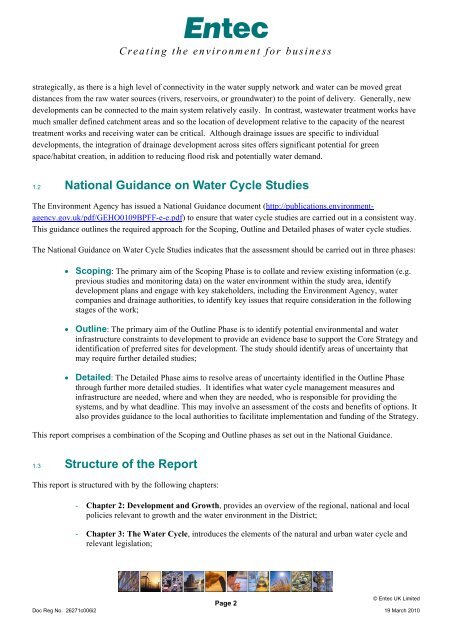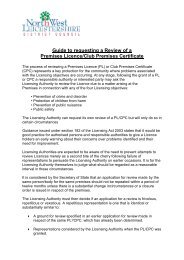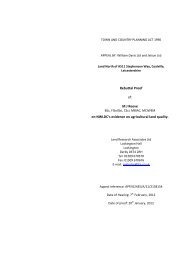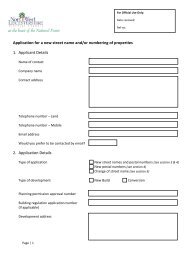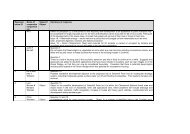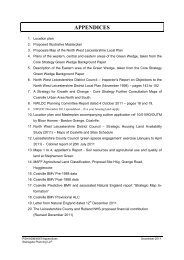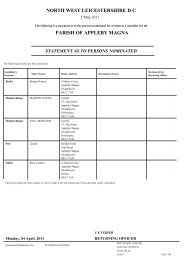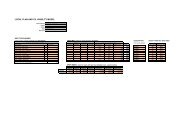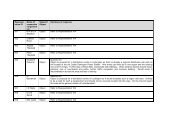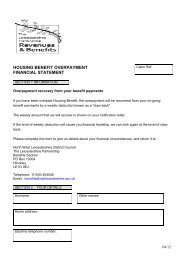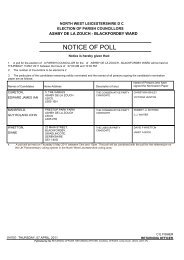Water Cycle Study - March 2010 - North West Leicestershire District ...
Water Cycle Study - March 2010 - North West Leicestershire District ...
Water Cycle Study - March 2010 - North West Leicestershire District ...
Create successful ePaper yourself
Turn your PDF publications into a flip-book with our unique Google optimized e-Paper software.
Creating the environment for business<br />
strategically, as there is a high level of connectivity in the water supply network and water can be moved great<br />
distances from the raw water sources (rivers, reservoirs, or groundwater) to the point of delivery. Generally, new<br />
developments can be connected to the main system relatively easily. In contrast, wastewater treatment works have<br />
much smaller defined catchment areas and so the location of development relative to the capacity of the nearest<br />
treatment works and receiving water can be critical. Although drainage issues are specific to individual<br />
developments, the integration of drainage development across sites offers significant potential for green<br />
space/habitat creation, in addition to reducing flood risk and potentially water demand.<br />
1.2 National Guidance on <strong>Water</strong> <strong>Cycle</strong> Studies<br />
The Environment Agency has issued a National Guidance document (http://publications.environmentagency.gov.uk/pdf/GEHO0109BPFF-e-e.pdf)<br />
to ensure that water cycle studies are carried out in a consistent way.<br />
This guidance outlines the required approach for the Scoping, Outline and Detailed phases of water cycle studies.<br />
The National Guidance on <strong>Water</strong> <strong>Cycle</strong> Studies indicates that the assessment should be carried out in three phases:<br />
• Scoping: The primary aim of the Scoping Phase is to collate and review existing information (e.g.<br />
previous studies and monitoring data) on the water environment within the study area, identify<br />
development plans and engage with key stakeholders, including the Environment Agency, water<br />
companies and drainage authorities, to identify key issues that require consideration in the following<br />
stages of the work;<br />
• Outline: The primary aim of the Outline Phase is to identify potential environmental and water<br />
infrastructure constraints to development to provide an evidence base to support the Core Strategy and<br />
identification of preferred sites for development. The study should identify areas of uncertainty that<br />
may require further detailed studies;<br />
• Detailed: The Detailed Phase aims to resolve areas of uncertainty identified in the Outline Phase<br />
through further more detailed studies. It identifies what water cycle management measures and<br />
infrastructure are needed, where and when they are needed, who is responsible for providing the<br />
systems, and by what deadline. This may involve an assessment of the costs and benefits of options. It<br />
also provides guidance to the local authorities to facilitate implementation and funding of the Strategy.<br />
This report comprises a combination of the Scoping and Outline phases as set out in the National Guidance.<br />
1.3 Structure of the Report<br />
This report is structured with by the following chapters:<br />
- Chapter 2: Development and Growth, provides an overview of the regional, national and local<br />
policies relevant to growth and the water environment in the <strong>District</strong>;<br />
- Chapter 3: The <strong>Water</strong> <strong>Cycle</strong>, introduces the elements of the natural and urban water cycle and<br />
relevant legislation;<br />
Doc Reg No. 26271c006i2<br />
Page 2<br />
© Entec UK Limited<br />
19 <strong>March</strong> <strong>2010</strong>


